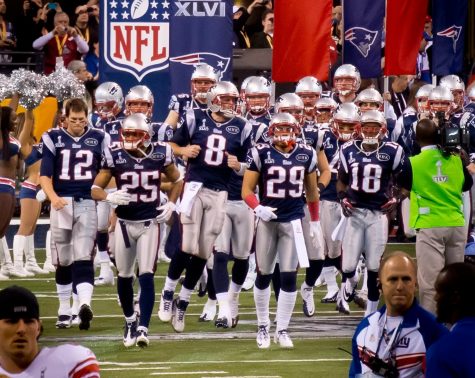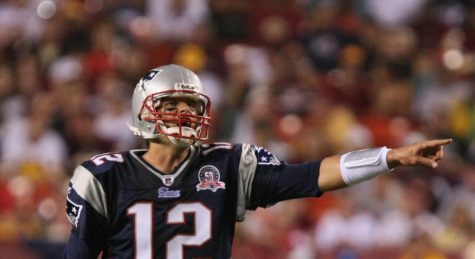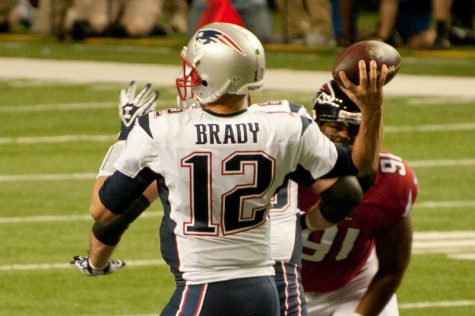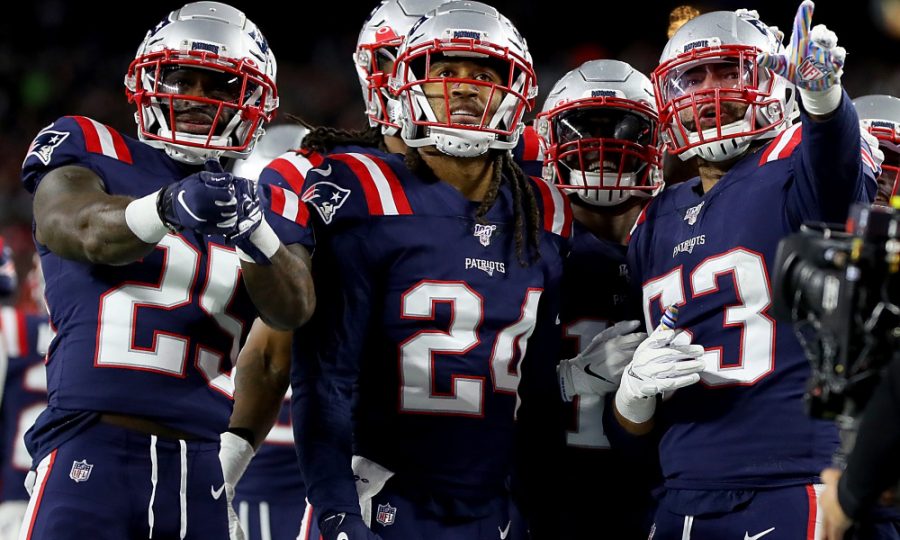Getty Images
FOXBOROUGH, MASSACHUSETTS – OCTOBER 10: Kyle Van Noy #53 of the New England Patriots celebrates with his teammates Terrence Brooks #25, Stephon Gilmore #24 and Matthew Slater #18 after recovering a fumble to score a touchdown against the New York Giants during the fourth quarter in the game at Gillette Stadium on October 10, 2019 in Foxborough, Massachusetts. (Photo by Maddie Meyer/Getty Images)
No longer invincible
The Patriots experience difficulties after breaking barriers in NFL history
The New England Patriots entered its 50th season in the National Football League as six-time defending Super Bowl champions and as three-time defending American Football Conference (AFC) champions.
As many avid fans predicted, the Patriots started the season strong, with an 8-0 record for the third time in franchise history. They won their division, the AFC East, for the 11th season in a row — the Patriots seemed invincible.

The Patriots’ winning streak came to an end in Week 9. For the first time since the 2013 AFC Championship, the Patriots experienced defeat during a game against the Baltimore Ravens. Despite this, the team maintained its momentum and entered December 10-1. But to many fans’ disappointment, the Patriots experienced their first home loss to the Miami Dolphins since 2008 during Week 17. This loss, in addition to the Kansas City Chiefs’ victory over the San Diego Chargers, left the Patriots without a first round bye in the AFC playoffs for the first time since 2009.
Once deemed unbeatable, the Patriots were left in a vulnerable state. This downward spiral continued and the Patriots lost to the Tennessee Titans 20-13 during the wild card round — the first time they lost a home playoff game since 2012, the first time they failed to reach the Divisional round since 2009, the first time they did not qualify for the AFC Championship game since 2010 and the first time they were unable to make it to the Super Bowl since 2015.
As a Patriots fan since his freshman year in high school, math teacher Joe Kim expresses his disappointment over the Patriots’ inability to make it to the Super Bowl this year. He attributes most of the team’s difficulty to the weaker roster. In addition to letting go of key player Antonio Brown due to his locker-room character issues and allegations of sexual assault and rape, Kim notes that the team in general could have been stronger.

“The offensive side and the defensive side were pretty good, but the offensive side was a little bit weaker and they didn’t have good performances by their wide receivers,” Kim said. “Tom Brady wasn’t playing as well, but part of it is because they didn’t have good wide receivers or tight ends that could actually receive, so it was problematic.”
Senior Aditya Chittari agrees with Kim, citing the team’s lack of cohesion as one of the main reasons behind the Patriots’ unexpected losses this season.
“It’s a combination of factors,” Chittari said. “We didn’t have enough talented personnel to match up with the Titans, especially since they run the ball so much. Plus, we didn’t have good enough wide receivers.”
Furthermore, Kim notes that there is a trend as to which games the Patriots tend to lose. When the team is against a team that has a player or coach associated with Patriots head coach Bill Belichick, they tend to perform worse.
“The coach of the Tennessee Titans is actual a former player for Bill Belichick who is the coach for the Patriots,” Kim said. “So anytime he plays a former player or coach he used to work with, he loses because they know the system and how to prepare.”
On the other hand, senior Sayalee Mylavarapu explains that while she loves the Patriots, the team is somewhat overconfident due to their many successes, which may hinder their performance.
“They do have an ego in the sense that they think, ‘Oh, we’re always going to win,’” Mylavarapu said. “So they go a little easier, especially on teams that everyone knows that you normally win against. But in the wild card game because they went so easy, they weren’t able to catch up afterwards.”
With the string of losses for the Patriots, Kim explains that there is definitely more doubt in the community regarding whether the Patriots will be able to make a strong return next year due to a variety of factors, including aging quarterback Tom Brady.

“There’s a lot of uncertainty moving forward,” Kim said. “I think Tom Brady’s going to come back, but then they would really need to give him more help because he’s only aging, he’s getting slower and his arm strength isn’t as good. He has a great defense, which is fine, but he needs better receivers and a better tight end that can receive, that can help him out.”
Despite the team’s recent losing streak, Chittari explains that he will continue to support the Patriots as he has always done.
“They still made the playoffs and they’re still a really good team,” Chittari said. “Last year we went 11-5 and won the Super Bowl but this year we went 12-4.”
Mylavarapu agrees with Chittari, adding that experiencing defeat is a completely normal experience for all sports teams.
“I think that every team goes through a bad year or two,” Mylavarapu said. “I think it’s amazing that in the beginning that they were strong in being undefeated, but obviously sometimes things just happen and you can’t get the results you want.”

